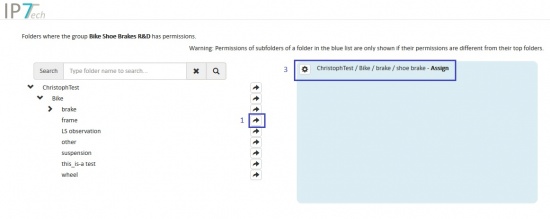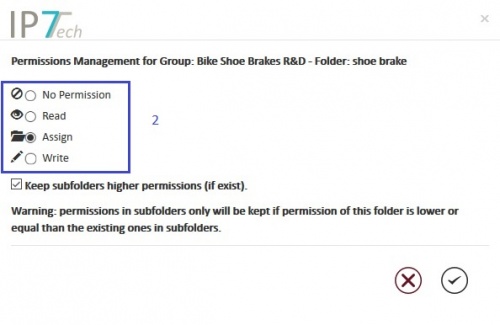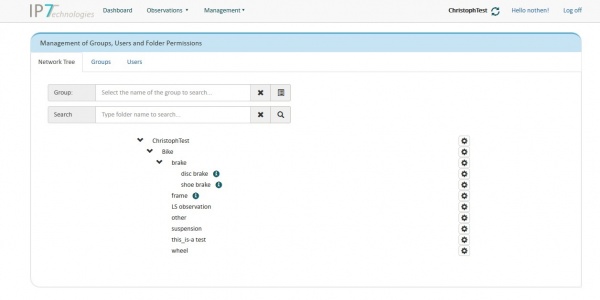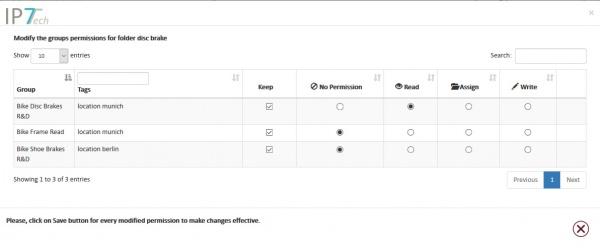EN:network administration
This article is only of interest to users which own an account with Administrator rights.
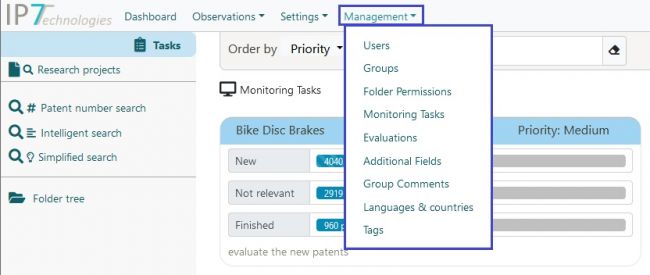
In a network respective permissions need to be set for users.
These permissions can only be assigned by a user with administrator rights in the web application (https://web.ip7.tech).
User administration

With the user administration, users can be created, edited or deleted.
Additionally, a list of all exiting users can be exported to Excel.
In the menu item "Management" - "Users & Groups" 3 tabs are available:
- Network Tree
- Groups
- Users
Under "Users", the users can be managed.
Groups

Assigning the rights is always carried out via groups and can’t be performed for individual users.
A group, for example, has the permission to access a specific folder thus all users assigned to this group possess this permission.
In the menu item "Management" - "Users & Groups" 3 tabs are available:
- Network Tree
- Groups
- Users
Under "Groups", the groups can be managed.
Using the pen icon folder permissions for the selected groups can be set/edited.
1 – Select folder 2 – Select permissions 3 – Permission is displayed in the list
Folder permissions
Permissions can be set for all folders in a network.
In the menu item "Management" - "Users & Groups" 3 tabs are available:
- Network Tree
- Groups
- Users
Under "Network Tree" the folder permissions can be managed:
Here, the respective permissions can be assigned to groups for a selected folder.
By clicking the gear icon on the right of a folder, the window for assigning the permission will open:
Group comments
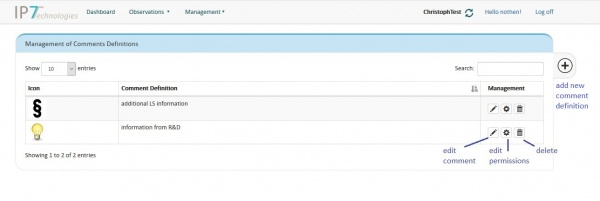
In a network it is possible to assign comments under specific aspects.
“Group comments” can be created.
For these comments, specific permissions can be assigned to desired groups.
It is also possible to add individual icons to the “Group comments”.
additional fields

Using "additional fields” you can define your own fields which can subsequently be filled by users.
This way it is possible, for example, to create additional fields with internal classifications or internal reference numbers.
The respective permissions can then be assigned to the desired groups.
Once an additional field is created, to options are available:
- Text
- Number
For this type of field the maximum area can be defined.
This way a field, e.g. “RFN” (reference number) can be created using the field type “Text”, which allows a maximum of 12 characters.
Tags
Users, groups and monitoring tasks can be tagged.
This way it is possible to, for example, set up groups for specific sites.

Evaluations

It is possible to set up/edit specific evaluation criteria for evaluations.
Here, the respective permissions can be assigned to the desired groups.
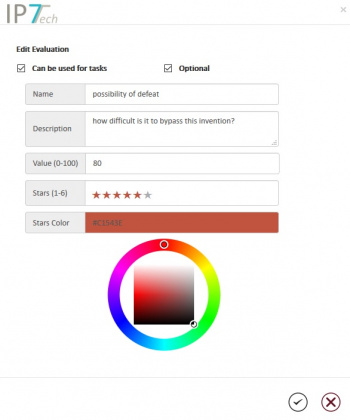
When creating evaluation criteria, the following settings can be assigned:
- Can be used for tasks
Make evaluation criteria useable for Ad-hoc tasks.
- Name
Users can see this name when assigning evaluations.
- Description
Users can read this description when assigning evaluations.
Here a description can be given on what the users should evaluate.
Example: Please evaluate the simplicity of this specific patent being circumvented.
- Value
Please refer to the chapter “Average value when using multiple evaluations“ on the page evaluation to see how the effects of the assigned value.
- Stars
Here you can select, how many stars are available for the users when assigning evaluations.
You can choose between 1-6 stars.
- Stars Color
The color of the stars can also be selected.
In case multiple criteria are used to create an evaluation, it might be helpful to use different colours.
Monitoring Task

Monitoring tasks can be created and edited.
Here it is also possible to assign permissions for the desired groups.
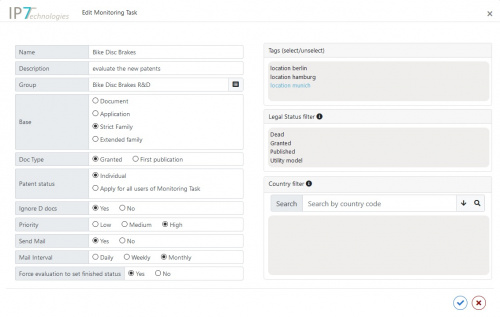
When creating monitoring tasks, the following settings can be chosen:
- Name
- Description
- Group
All users assigned to this group are selected for the monitoring task.
Also, specific permissions can be selected for the individual group.
This relates to evaluation criteria, additional fields and group comments.
When the monitoring task is subsequently opened by users, only the selected fields are visible/useable.
- DocType
If the monitoring task contains multiple documents for one application and the setting is “A-Application” it is possible to select whether the application or the grant is displayed.
- SearchType
Here the basis of the results is displayed.
- Patent Status
"Individual" – every user can assign a patent status.
"Apply for all users of Monitoring Task" – all users share the status.
If the status “OK” is set for a patent, all other users will see this status.
- Ignore D docs
This way, documents like GB D0 are ignored and not displayed as new results.
- Mail inform
All users assigned to this monitoring task are informed by E-Mail about new patents.
- Mail interval
The interval used to send these E-Mails.

